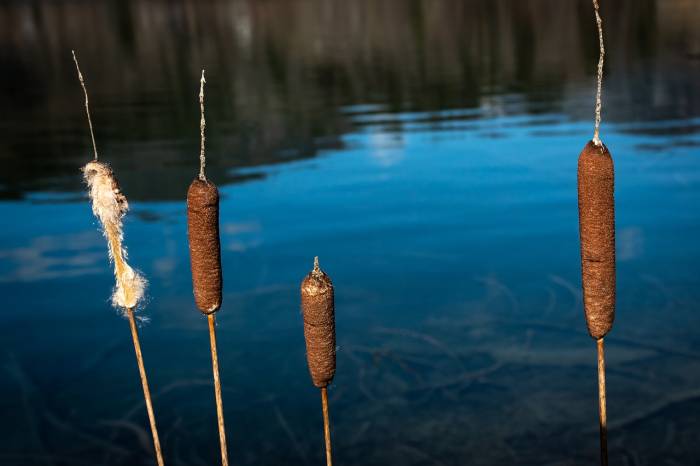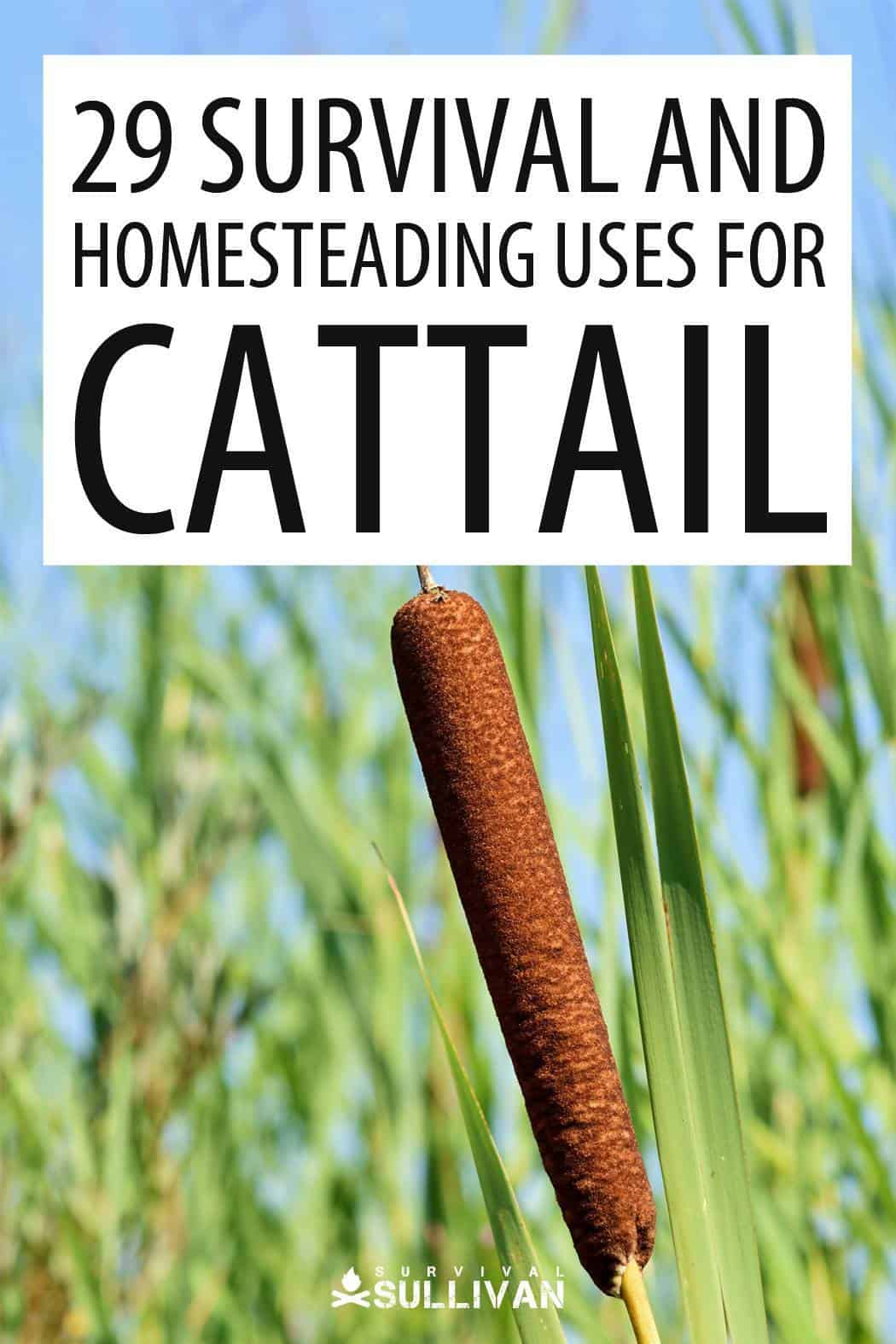The American cattail (Typha latifolia) is a plant often found growing densely in wetlands, and other marshy areas. It grows up to 10 feet tall, and consists of a root (or rhizome), stalk, grass-like leaves, and cylindrical flower head called a spike or catkin.

All parts of the cattail – tuber, stalk, leaves, and catkin – have a multitude of uses both in a survival situation and on the homestead.
If you’re a prepper on the run, finding cattail can provide you with four essential survival items – food, shelter, first aid, and fuel.
If you’re a homesteader, then having a patch of cattail on your land or growing nearby in the wild provides you with many different food, medicinal, and valuable uses.
Survival Uses for Cattail Catkins
Tinder
The cattail fluff, which is a soft and fibrous material, can be removed from the flower head. Mixed with other fibers, it’s ideal for catching sparks from your fire-starting kit.
Char Cloth
Char cloth, a burned tinder used for starting fires with flint and steel, can be made from burned cattail fluff.
Pack a metal container with the fluff, pierce some holes in the container, and place it in your campfire for a few minutes. Then remove the container and let it cool. Inside the container is char.
Insulation
Similar to feather down, cattail fluff can be used to stuff your clothes, boots, and any other garments to provide additional warmth.
Insect Repellent
If mosquitoes or other insects are an annoyance at night, you can smolder the seed head. Remove it from the fire and its smoke will repel insects for up to 30 minutes.
Food
In the spring, when the catkins are still green and hidden behind the leaves, you can boil them and eat them like corn on the cob.
First Aid
Combine the fluff with animal fat to make a soothing poultice for burns or bruises.
Homesteading Uses for Cattail Catkins
Lamp Wicks
Add a small amount of cattail fluff to the top of oil, and it works as a wick.
Culinary Uses
Catkins produces a number of edible staples that can be used in a surprising number of recipes on the homestead.
Pollen Flour
In the summer, once the catkins have matured, harvest the pollen by putting the catkins in bags and shaking off the pollen. It can be used as a protein-rich substitute for flour.
Pollen Biscuits
Take one-third cup of pollen, one and three-quarters cups of flour, two to three teaspoons of baking powder, and two-thirds cup of milk. Mix and cut out biscuit shapes. Bake at 425 degrees for about 20 to 25 minutes.
Pollen Pancakes
Mix one-half cup of pollen, two-thirds cup of flour, one to two tablespoons of baking powder, an egg, a cup of milk, two to three tablespoons of lard or tallow, and salt. Let sit for 15 minutes, then pour individual servings into a hot skillet.
Diarrhea Alleviation
When very young, the flowerheads can be eaten to help with diarrhea or dysentery.
Survival Uses for Cattail Leaves
Shelter
The leaves can be dried and woven into roof coverings on your ad-hoc shelter.
Sleeping Mat
After putting down some dried leaves, you can weave the rest into a sleeping mat on top.
Rope
Weave strips of leaves together to make a serviceable, makeshift rope.
Antiseptic
Burn down the leaves to form ashes for a numbing antiseptic. It is also a blood coagulant.
Using Cattle Leaves on the Homestead
Weaving
The items you can weave with leaves are only limited by your imaginations. Chair seat, baskets, hats and many other useful items are possibilities. While the weaving is best done when the leaves are pliable, once woven, the item will dry out and retain its strength.
Washing
The leaves can be boiled to make a weak soap substitute for washing the skin.
Survival Uses for Cattail Stalks
Fuel
Last year’s stalks, which have dried and hardened up, make a great supplemental fuel for a fire.
Food
Young cattail stalks have two parts: shoot inside and an exterior sheath. Once the sheath is removed, the young shoots can be fried in the skillet.
Although these shoots are called Cossack asparagus, their flavor is more reminiscent of cucumbers. But they make a great accompaniment to any wild game roasting on the camp fire.
Antiseptic
At the base of younger cattail stalks, there are droplets of sap. This can be applied to wounds to ward off infection.
Toothaches
A toothache can be a serious detraction from the attention a survivalist needs. The sap can be used to soothe a sore tooth so you get back to focusing on business.
Cattail Shoots Recipes
Scalloped Cattails
Chop up two cups of cattail shoots and mix them in a bowl with two eggs, one stick of butter, and a half teaspoon of sugar and pepper.
Puree and then slowly introduce one cup of scalding milk into it. Pour the mixture into greased cupcake tins and top with cheese and butter. Bake at 300 degrees for 25 minutes.
Stir-Fried Shoots
Heat two tablespoons of butter in a skillet on medium heat. Add in chopped cattail shoots and sauté for a few minutes until softened. Add a diced onion, two minced garlic gloves, and pepper.
Continue frying until the onions are translucent. Meanwhile, cook rice in a separate pot. Then stir in the fried vegetables with the rice, and serve. Get the full recipe instructions here.
Survival Uses for Cattail Roots
A survivalist will find many uses for cattail rhizomes.
Food
Dig up a bunch of cattail roots and cut away smaller branches. You can grill or boil the roots. However, once they’re cooked, you must take care in eating them. They consist of starch and fibers.
The fibers aren’t edible, so eat the roots like an artichoke leaf – strip away the starch from the fibers and spit out the fibers.
First Aid
A soothing poultice can be made from the mashed root starch for cuts, stings, or burns.
Uses for Cattail Roots on the Homestead
Flour
Harvest the roots when they are tough and fibrous. Peel off the outer fibrous layer, chop up the root core, and dry them. Then grind into a flour.
Roasted Root Chowder
Take four large, dried cattail roots with the woody exterior removed. Boil them in four to five cups of salted water for 45 minutes. Add one to two pounds of cut up fish and simmer for another five to ten minutes. Add pepper to taste and enjoy.
Coffee Substitute
Roast, dry and rough grind the cores of roots. Percolate like coffee for a satisfying hot drink.
Nature’s Bounty
The wild provides an unending bounty for survivalists and homesteaders. Cattails are a prime example. Whether you’re a survivalist camped out on the run, or a homesteader maximizing the yield of your land, cattails provide many benefits – from fire-starters to fuel, from food to first aid, and from crafts to everything else.
So next time you’re near water, keep an eye out for this amazing resource provided by nature.


My dad was military. My grandfather was a cop. They served their country well. But I don’t like taking orders. I’m taking matters into my own hands so I’m not just preparing, I’m going to a friggin’ war to provide you the best of the best survival and preparedness content out there.
